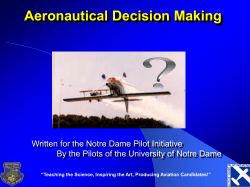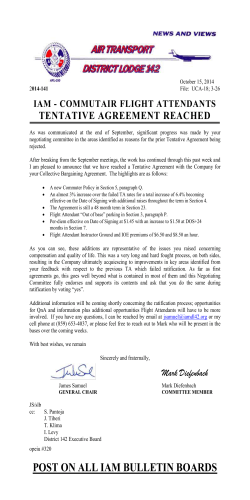
PDF-Download
JINKER Jump-induced Kinetik Energy Rebounder by Nikolaus Pietrek DESCRIPTION OF THE KEY POINT ASPECTS OF THE INVENTION -1- JINKER with unilateral fuselage, perspective 5: Flexible frame with fixed, downwards-curved wings 6: Control handles for rudders and rear elevator wing 7: Pilot´s pedestal 8: Rear elevator wing The invention is a light, portable flight apparatus with a fuselage, a flexible frame and downwards-curved fixed wings. The Jinker is started from an elevated place like a ramp or a hill. The pilot runs towards the wind until the ornithopter is carried by the airflow. He then jumps from behind onto the frame, which is open in the rear and he starts to glide first. -2- After that, the pilot initiates the flapping of the wings by gently jumping on the plane and slowly and rhythmically increasing the body acceleration and frequency. „Snowbird“ Ornithopter September 2010 Traditionally, wings of aeroplanes are constructed in a straight manner. Under the load of the weight of the pilot and the plane itself, the wings tend to bend upwards. This makes the wings less efficient because of the reduced projected area and the slope of the wings. With the flexible pre-bent, fixed-wing-construction of my invention, the contrary is achieved: The wings tend to stretch under the load and therefore they become more efficient. The degree of stretching is directly dependent on the amount of load. -3- The power for the flapping of the wings being made available by the pilot by jumping (Body weight acceleration), he constantly changes the degree of stretching, thus inducing the flapping. 1: 2 - 3g load (Maximum body weight acceleration of the jumping pilot) 2: 1g load (Weight of the pilot + plane. Gliding flight) 3: Zero g load. Rest position 4: Wing slightly overbent after flapping The key of this way of power input is the positive energy balance of the process: The energy needed for one pilot´s jump is about 2-3 fold the pilot´s body weight. Because the wings are stretched during the power input, the counter-bearing against his jump is raised gradually, the jump becomes more efficient and the loss of altitude is minimized. When the jumping movement is finished, the weight of the pilot does not last on the plane any more. Now the plane incorporates a manifold of the energy needed for a flight with or without the pilot as tension in its wings. The energy is now automatically released from the wings and frame by a flapping motion (As a result of the energy release) and is used either for acceleration or gaining of height of the (now) “singular ballistic body ornithopter”. -4- On the following pages the process of energy input during one flapping cycle is described stepwise and simplified: Please note the position of the rear elevator wing. Gliding MODUS: The pilot gets ready for the jump Climb Flight Rear elevator wing and lateral rudder in neutral position Elevator wing Wingspar Fig. 3.1 -5- Lateral rudder Phase of maximum body weight acceleration MODUS: Pilot provides maximal energy into the system Climb Flight Wings have maximum tension Fig. 3.2 End of body weight acceleration MODUS: Rear elevator wing positioned for climbing Climb Flight Wings start to release energy Lateral rudders show downwards, assisting the flapping motion Fig. 3.3 -6- Pilot flies upwards due to his jump and briefly loses contact to the plane MODUS: Climb Flight Rear elevator wing in neutral position The „singular ballistic body“ plane follows the „singular ballistic body“ pilot and transforms the released energy into gaining height Lateral rudders show downwards, assisting the flapping motion Fig. 3.4 The jump of the pilot ends in a parabolic flight MODUS: The pilot contracts his legs in order to not inhibit the climbing of the plane Climb Flight Fig. 3.5 -7- The plane is forced into gliding with the rear elevator wing MODUS: The pilot continues to contract his legs and biomechanically prepares for the next jump Climb Flight The lateral rudder is put back into neutral Fig. 3.6 Gliding MODUS: The pilot gets ready for the jump Climb Flight Rear elevator wing and lateral rudder in neutral position Fig. 3.7 -8- A similar principle is successfully applied to operate the “AquaSkipper” device below … The most simple and appropriate way to describe my invention would be that of a „Wing-Shaped, Flying Trampoline“. The pilot´s aim as energy-deliverer and markedly heavier one of both ballistic bodies has to be to have the Jinker accompanying him during the flight, similar to the role of the torso of a bird, to use the ornithopter as trampoline and to jump from pressure point to pressure point. Comparable ballistic momentums can be observed during the performance of the „Akrobat Bikers“ from Ukraine, who do somersaults with their relatively light tyre – hoses. -9- It is the duty of the pilot, to harmonize and to conduct the predescribed process with the pertinent bionical, flight-dynamic and ballistic momentums and characteristics in order to achieve the climb flight with flapping wings. Of course, the above described process to conduct a flight with this ornithopter is only related to one single flight modus. The requirements for a sustained and controlled flight from A to B are manifold and are thoroughly described in the pertinent patent DE102007060176. In a distinct Proof of Concept, calculations reveal very promising performances under different conditions and with different lay-outs in terms of wingspans, weights and speeds. I pursue the aim of establishing the Jinker as a sports equipment for a new olympic discipline. For this puspose, to win the “Kremer Prize Sports”, called out 70 years ago under the wing of the Royal aeronautic Society in the UK could be a perfect platform. One basic aim of the sponsor of this prize was to establish a popular, man-powered flight sports for olympic contests. I consider the use of the Jinker for private purposes, without the embedment into flight clubs with tight training methods and well organized structures as being too dangerous and I therefore will refrain from releasing it to the public. In the environment of a sports competition, the Jinker offers ideal possibilities for advertisements due to the huge surfaces of the wings and fuselage. Rallyes, short track races or skill competitions can be envisioned, all to be performed either in nature or big open stades. The new sport discipline could be structured in classes and ligues and different cups can be called out. - 10 - Oportunities for partners 1: The first successful flight of the Jinker will be an unprecedented and unrepeatable event which will set undeletable footprints in the history of aeronautics and which will anchor all partners very prominently in the history books! This is a true prestige project. 2: This is a unique opportunity to elaborate and to establish new sports disciplines, to market it, to set up its rules and to develop new techniques and equipment! 3: After the predictable and lucrative “hype” with uncountable klicks on the web, the created and sustained values will be: Licenses for the manufacturing, fees for the participation on the competitions, TVrights, fees for advertising, cooperations with fashion labels, licensing to scale model manufacturers, to name a few! I would be extraordinarily delighted if I could inspire you with this unique project! Nikolaus Pietrek Drosselstrasse 34 14612 Falkensee Tel.: 0049 172 3242291 Email: amb@pietrek.biz - 11 -
© Copyright 2025









